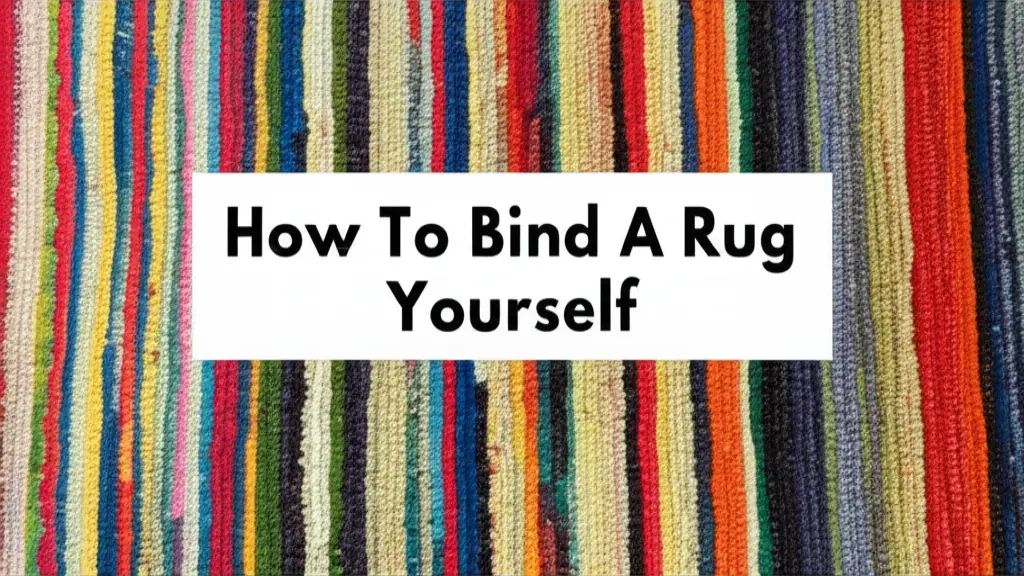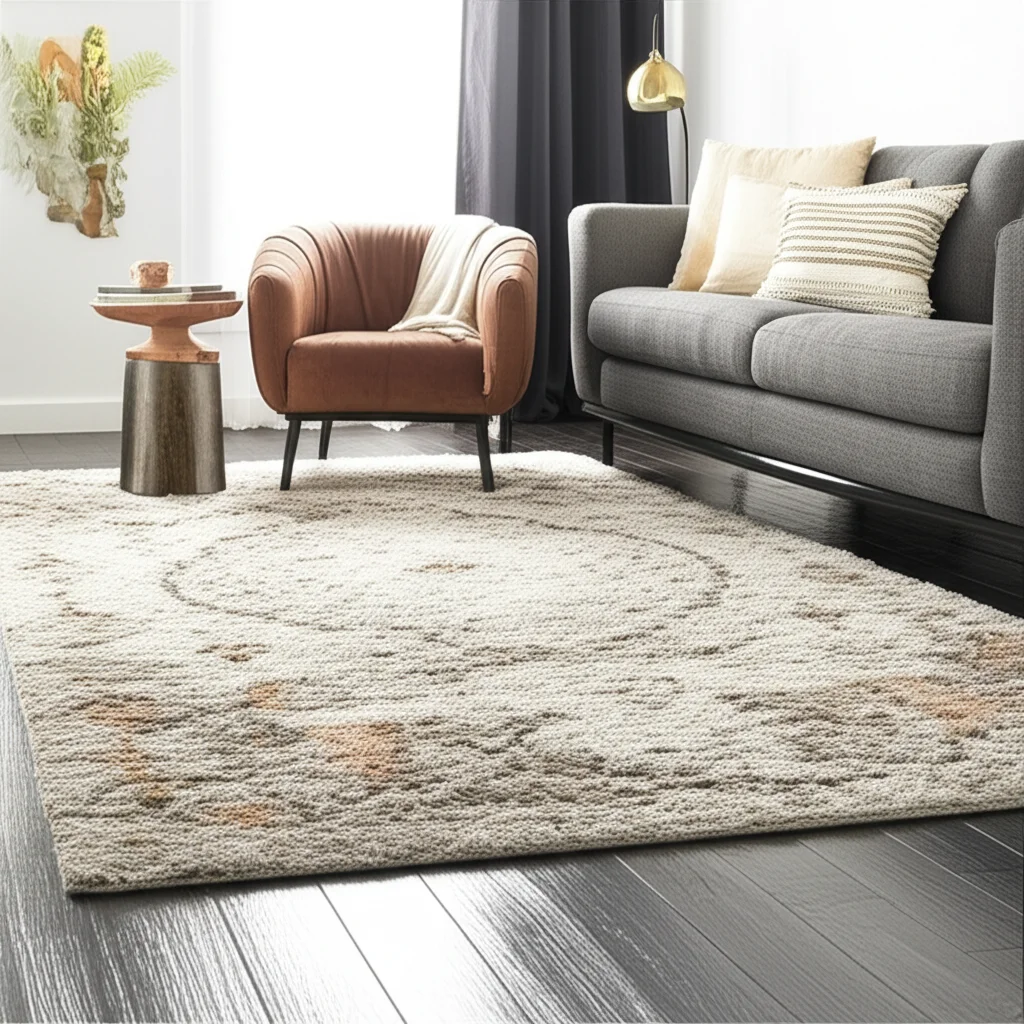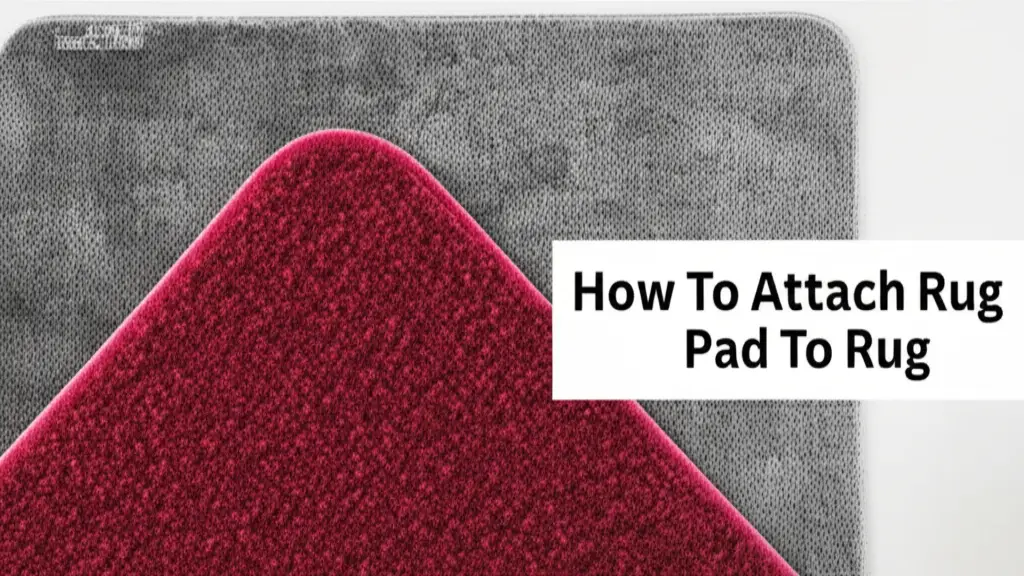· Todd Martin · Rugs · 16 min read
How To Bind A Rug Yourself

How to Bind a Rug Yourself: The Complete DIY Guide
Have you ever found the perfect rug, only to discover it’s too large for your space? Or perhaps you’ve noticed your existing rug’s edges fraying and unraveling? Learning how to bind a rug yourself can save you significant money while extending the life of your floor coverings. Rug binding not only creates a clean, finished edge but also prevents fraying and damage over time.
In this comprehensive guide, we’ll walk through everything you need to know about DIY rug binding, from selecting the right materials to mastering various binding techniques suitable for different rug types.
Key Takeaways:
- Binding your own rug can save 50-70% compared to professional services
- Multiple binding methods exist for different skill levels and rug types
- With proper tools and techniques, DIY rug binding delivers professional-quality results
- Binding extends rug lifespan by protecting edges from fraying and unraveling
In short: Yes, you can definitely bind a rug yourself with basic tools and materials. The process involves measuring, cutting (if needed), and applying binding using one of several methods like sewing, using binding tape, or installing edge binding strips.
Why Bind Your Own Rug?
Rug binding is an essential process that finishes raw edges, creating a clean, professional look while preventing fraying and unraveling. When considering whether to tackle this project yourself or hire a professional, there are several compelling reasons to choose the DIY route:
Cost Savings
Professional rug binding services typically charge $2-$5 per linear foot, which can quickly add up for larger rugs. For example, binding an 8’×10’ rug professionally might cost $70-$180. By contrast, DIY binding materials for the same rug would cost approximately $20-$60, depending on the binding method chosen. This represents a significant savings of 50-70%.
Customization Options
When you bind a rug yourself, you gain complete control over the appearance. You can select binding materials that perfectly complement your rug’s colors and texture. Options include:
- Matching or contrasting color tape binding
- Wide or narrow binding widths
- Decorative binding styles like serging or fringe
- Custom corner treatments
Professional services often limit your choices to their standard offerings, whereas DIY allows unlimited creativity.
Convenience
Rather than transporting your heavy rug to a binding service and waiting days or weeks for completion, DIY binding can be done at your convenience, right in your home. This is especially valuable for:
- Large, awkward rugs difficult to transport
- Rugs in high-traffic areas you need back in service quickly
- Custom-cut rugs from carpeting remnants that need immediate finishing
Learning to bind rugs yourself also creates a valuable skill that can be applied to future projects, including repairing existing rugs when binding begins to deteriorate.
Essential Tools and Materials for Rug Binding
Before beginning your DIY rug binding project, gathering the right tools and materials is crucial for achieving professional results. The specific items you’ll need depend on which binding method you choose, but here’s a comprehensive list covering most common approaches:
Basic Tools:
- Measuring tape - For precise measurements of your rug and binding materials
- Sharp scissors or utility knife - For clean cutting of binding materials
- Straight edge or T-square - Ensures straight lines when measuring and cutting
- Pencil or fabric marker - For marking measurements on binding materials
- Heavy-duty stapler - For temporary securing of binding while working
- Iron - Required if using heat-activated binding tape
- Sewing machine (for sewn binding methods) - Heavy-duty model preferred for thick materials
Materials for Different Binding Methods:
For Tape Binding:
- Carpet binding tape - Available in various widths (typically 2-4 inches) and colors
- Heat-activated binding adhesive - If not already included in the binding tape
- Double-sided carpet tape - For securing binding before permanent attachment
For Sewn Binding:
- Binding fabric - Typically cotton or polyester fabric strips cut on the bias
- Heavy-duty thread - Matches or complements your binding color
- Upholstery needles - For hand-sewing sections if needed
For Instabind or Edge Binding Systems:
- Instabind strips - Pre-made binding strips available in various styles and colors
- Specialized adhesive - Usually recommended by the binding system manufacturer
- Applicator tools - Often included with binding systems
Additional Helpful Items:
- Work gloves - Protects hands when handling rough materials
- Knee pads - For comfort during floor work
- Seam roller - Ensures strong adhesion for tape binding methods
- Corner templates - Helps achieve neat, professional corners
For beginners, I recommend starting with a pre-made binding system like Instabind or using binding tape, as these methods require fewer specialized skills than sewn binding. Quality materials make a significant difference in durability, so invest in commercial-grade binding supplies if possible.
Step-by-Step Guide to Binding a Rug with Tape
Binding tape is one of the most accessible methods for DIY rug binding, requiring minimal specialized tools while delivering durable results. This method works well for most area rugs and carpet remnants. Follow these detailed steps for professional-looking edges:
1. Preparation and Measuring
Begin by thoroughly cleaning your rug and allowing it to completely dry. Dirt or moisture can prevent proper adhesion of the binding tape.
Next, measure the perimeter of your rug accurately:
- Lay the rug flat on a clean, level surface
- Use a measuring tape to determine the exact length of each side
- Add these measurements together for the total perimeter
- Add 8-12 extra inches to account for corners and potential mistakes
For example, an 8’×10’ rug would need approximately 36 feet of binding tape (8+10+8+10 = 36), plus about 1 extra foot for safety.
2. Cutting the Rug (If Necessary)
If you’re binding a carpet remnant or need to resize your rug:
- Measure and mark your desired dimensions using a straight edge and pencil
- Place a cutting board or scrap wood underneath the cutting line
- Use a sharp utility knife to cut along the marked line, making multiple passes if needed
- Cut from the back of the rug when possible for cleaner edges
Ensure all edges are straight and clean before proceeding, as irregularities will be visible in the finished binding.
3. Applying the Binding Tape
Most carpet binding tape features a heat-activated adhesive on one side. Follow these steps:
- Position the binding tape along the edge of the rug with the adhesive side facing down
- Allow the tape to extend equally on both the top and bottom surfaces (typically 1-1.5 inches on each side)
- Secure the tape temporarily with pins or heavy-duty staples (which will be removed later)
- Start in the middle of one side rather than at a corner
4. Heat-Setting the Binding
- Set your iron to the appropriate temperature (usually medium-high, but follow manufacturer instructions)
- Press the iron firmly on the binding tape for 10-15 seconds, moving in small sections
- Use a pressing cloth between the iron and binding tape to prevent scorching
- Apply pressure after heating to ensure solid adhesion
- Allow each section to cool before moving to the next
5. Creating Neat Corners
Corners require special attention for a professional finish:
- When you reach a corner, cut the binding tape at a 45-degree angle, leaving a small overlap
- Fold the binding around the corner, creating a mitered edge
- Apply a small amount of fabric glue at the corner junction for reinforcement
- Heat-set the corner thoroughly, applying pressure as it cools
6. Finishing Touches
After binding the entire perimeter:
- Remove any temporary staples or pins
- Trim any excess binding tape with sharp scissors
- Go around the entire rug once more with the iron to ensure all binding is securely attached
- Use a seam roller to firmly press down all edges after heating
Allow the rug to cool completely (at least 1-2 hours) before moving or using it. For extra security, you might consider adding a few discreet stitches at high-stress points like corners.
Hand-Sewing Method for Binding Rugs
While more time-consuming than tape binding, the hand-sewing method offers unparalleled customization and durability for rug binding. This technique is particularly valuable for delicate, valuable, or antique rugs where heat-activated adhesives might cause damage. Follow this detailed process for professional results:
Choosing the Right Binding Material
For hand-sewn binding, you’ll need:
- Binding fabric - 2-3 inch wide strips of durable fabric (cotton canvas, twill, or polyester)
- Thread - Heavy-duty upholstery or carpet thread that matches your binding color
- Needles - Sturdy upholstery needles with a sharp point
Pre-made binding tape is available, but for custom looks, you can create your own by cutting fabric strips on a 45-degree bias (diagonally across the grain). This allows the binding to bend smoothly around corners.
Preparing the Binding
If making your own binding:
- Cut fabric strips 2-3 inches wide at a 45-degree angle to the fabric grain
- Join strips with diagonal seams to create one continuous length
- Press the binding in half lengthwise with wrong sides together
- Press the raw edges inward toward the center fold, creating a finished tape
You’ll need binding length equal to the perimeter of your rug plus about 12 inches extra.
The Binding Process
Position the binding: Place the folded binding around the edge of the rug, encasing the raw edge completely. The binding should extend equally on both top and bottom surfaces.
Secure temporarily: Use binding clips or safety pins to hold the binding in place as you work. Space them about 6-8 inches apart.
Begin sewing: Using a whipstitch:
- Thread your needle with about 18 inches of thread and tie a knot at the end
- Start at a straight section (not a corner), leaving a 6-inch tail of binding
- Insert the needle from underneath the rug, catching both the binding and rug edge
- Pull through completely and bring the needle back around to the underside
- Continue with evenly spaced stitches (about 1/4 inch apart)
- Keep tension consistent but not so tight that it causes puckering
Navigating corners:
- When approaching a corner, sew until about 1 inch from the corner
- Create a mitered corner by folding the binding at a 45-degree angle
- Fold the binding back along the next edge, creating a neat diagonal fold
- Secure with additional stitches at the corner for reinforcement
- Continue binding along the next edge
Finishing the binding:
- When you reach your starting point, overlap the beginning binding by about 2 inches
- Trim excess binding at a 45-degree angle
- Tuck raw edges inside and sew closed with a ladder stitch
- Reinforce with additional stitches
This method typically takes 3-6 hours for an average-sized area rug, depending on your sewing experience. While time-intensive, hand-sewn binding can last for decades and offers a beautiful, customized finish that enhances your rug’s appearance and longevity.
Using Instabind and Other Pre-Made Binding Systems
Pre-made binding systems like Instabind offer an excellent middle ground between professional binding services and traditional DIY methods. These systems are specifically designed for home users who want professional-looking results without specialized equipment. Here’s how to use these convenient systems:
What Are Pre-Made Binding Systems?
Instabind and similar products consist of:
- Pre-formed binding strips with a finished outer edge
- Built-in adhesive channel that grips the rug edge
- Various profile options (flat, serged, wide, narrow)
- Diverse color selections to match or accent your rug
These systems eliminate the need for sewing machines or heat-setting, making them accessible to all skill levels.
Selecting the Right Binding System
When choosing a pre-made binding system, consider:
Profile style:
- Flat binding: Creates a clean, modern edge
- Serged binding: Mimics professional serging for a higher-end look
- Wide or narrow binding: Depends on your aesthetic preference
Color matching:
- Most systems offer 20+ color options
- Bring a sample of your rug when purchasing for accurate matching
- Consider contrasting binding for a decorative border effect
Amount needed:
- Calculate the perimeter of your rug plus 10% extra for corners and mistakes
- Most systems are sold in linear feet or in kits for standard-sized rugs
Application Process
Follow these steps to apply pre-made binding systems:
Preparation:
- Clean and dry the rug thoroughly
- Lay it flat on a clean, hard surface
- Cut the rug to size if necessary (follow the same cutting guidelines from earlier sections)
Measure and cut binding:
- Measure each side of your rug
- Cut binding strips for each side, adding 2-3 inches extra per side
- For corners, make 45-degree cuts where strips will meet
Apply adhesive:
- Most systems require applying a specific adhesive to the binding channel
- Follow manufacturer instructions for application method and amount
- Some systems feature pre-applied adhesive that requires activating
Attach the binding:
- Starting in the middle of one side, press the binding onto the rug edge
- Ensure the rug edge seats fully into the binding channel
- Work gradually along the edge, avoiding stretching the binding
- Use binding clips every few inches to hold in place while adhesive sets
Creating corners:
- At corners, create a mitered joint by cutting both connecting strips at 45-degree angles
- Apply a small amount of adhesive at the joint
- Press firmly together and secure with clips until set
Finishing:
- Once all sides are bound, inspect for any gaps or loose sections
- Apply additional adhesive to any problem areas
- Allow the binding to cure completely according to manufacturer instructions (typically 24 hours)
Advantages of Pre-Made Systems
These systems offer several benefits:
- Time-efficient: Most rugs can be completely bound in 1-2 hours
- Professional appearance: Results closely resemble commercial binding
- Durability: When properly applied, can last for years under normal use
- Versatility: Works on virtually any rug type, including delicate materials
- User-friendly: Requires no specialized skills or equipment
For those new to rug binding, systems like Instabind provide the confidence of a guided process while delivering results comparable to professional services. They’re particularly ideal for binding high-pile shag rugs or delicate materials that might be damaged by heat-setting or heavy sewing.
Maintaining and Repairing Bound Rugs
After successfully binding your rug, proper maintenance will ensure your handiwork lasts for years. Additionally, knowing how to repair minor binding issues can extend your rug’s life considerably without requiring complete rebinding.
Routine Maintenance for Bound Edges
Regular Inspection:
- Check binding edges monthly for signs of loosening or wear
- Pay special attention to high-traffic areas and corners
- Address minor issues immediately before they worsen
Careful Cleaning:
- Vacuum bound edges with reduced suction to prevent pulling
- Use brush attachments rather than powerful suction heads
- When cleaning your rug, avoid excessive moisture along bound edges
Reducing Stress Points:
- Rotate your rug every 3-6 months to distribute wear evenly
- Use rug pads to prevent shifting and reduce edge stress
- Keep pets with claws and children from pulling or playing with binding
Addressing Minor Fraying:
- Trim loose threads carefully with sharp scissors
- Apply a small amount of fabric glue to secure fraying sections
- For tape binding, a quick pass with an iron can reactivate adhesive
Common Binding Issues and Repairs
For Tape Binding:
Loosening edges:
- Clean the area thoroughly
- Apply thin double-sided carpet tape underneath
- Heat-set with an iron if using heat-activated binding
- Press firmly and allow to cool under weight
Damaged sections:
- Remove the damaged section of binding
- Cut a replacement piece slightly longer than the damaged area
- Apply following the original binding method
- Blend edges by slightly overlapping with existing binding
For Sewn Binding:
Loose stitching:
- Thread a needle with matching thread
- Reinforce existing stitches by following the same stitch pattern
- Secure with multiple knots on the underside
Worn binding fabric:
- If binding fabric is worn but stitches are intact, you can cover with new binding
- Apply thin fabric glue between old and new binding
- Stitch through all layers for maximum security
For Instabind and Pre-made Systems:
Adhesive failure:
- Clean both surfaces thoroughly
- Apply manufacturer-recommended adhesive or carpet seam sealer
- Secure with binding clips until fully cured
Corner separation:
- Apply small amounts of fabric glue into the separated corner
- Secure with binding clips or heavy weights
- For added security, add a few discreet stitches to reinforce
When to Rebind
Sometimes repairs aren’t sufficient, and complete rebinding becomes necessary. Consider rebinding when:
- More than 25% of the binding shows significant damage
- Multiple repairs have created an uneven or unsightly appearance
- Binding damage is affecting the structural integrity of the rug
- You’re changing your decor and want a different binding color or style
With proper maintenance and timely repairs, your DIY binding can last 5-10 years or more, depending on use and rug quality. For valuable rugs, consider rebinding every 7-10 years as preventative maintenance, even if damage isn’t yet visible.
Frequently Asked Questions
Can you bind a rug yourself?
Yes, you absolutely can bind a rug yourself with basic tools and materials. Depending on your skill level and the binding method chosen (tape, hand-sewing, or pre-made systems like Instabind), the process is accessible to most DIYers. The project typically takes 1-4 hours and can save 50-70% compared to professional binding services.
What will hold a rug in place?
Several effective methods can secure a rug in place: double-sided rug tape applied along the edges and center; non-slip rug pads cut slightly smaller than your rug; rug grippers placed at corners; furniture anchoring; or rug weights designed specifically for this purpose. For carpeted floors, special anchors can prevent sliding.
How do you bind a rug after cutting it?
After cutting a rug to size, clean the cut edge thoroughly to remove loose fibers. Then bind the edge using one of three primary methods: apply heat-activated binding tape, sew on fabric binding by hand or machine, or use a pre-made binding system like Instabind. Always work on a clean, flat surface and take extra care with corners for professional results.
Is it cheaper to bind carpet or buy a rug?
Binding carpet remnants is typically 40-60% cheaper than purchasing a comparable pre-made area rug. For example, a quality 8’×10’ area rug might cost $200-$600, while a similar-sized carpet remnant might cost $80-$200, plus $20-$60 in DIY binding materials. This approach also offers more customization in terms of exact size, material, and edge finishing.
How long does DIY rug binding last?
With proper application and maintenance, DIY rug binding can last 5-10 years under normal household use. Tape binding typically lasts 3-5 years before showing wear, while hand-sewn binding can last 7-10 years or more. Pre-made binding systems like Instabind typically provide 5-7 years of durability when properly installed and maintained.
Can all rug types be bound using the same method?
No, different rug materials and constructions require specific binding approaches. Delicate rugs like wool or silk are best bound using hand-sewing techniques. Synthetic rugs work well with tape binding. Thick or shag rugs often require specialized binding systems designed for high-pile materials. Always test your chosen method on a small area first.
Is professional binding worth the extra cost?
Professional binding offers advantages in durability and perfection for valuable or heirloom-quality rugs. However, for most standard area rugs, DIY binding provides comparable results at significant savings. The decision should factor in your comfort with DIY projects, the rug’s value, and how long you plan to keep the rug.
Final Words
Learning how to bind a rug yourself is a valuable skill that not only saves money but also gives you complete control over the appearance and quality of your finished rug. Whether you choose tape binding for its simplicity, hand-sewing for its customization, or pre-made systems for their convenience, proper binding extends your rug’s life while creating a professional, finished look that enhances your home decor.
Remember that successful rug binding begins with proper preparation, quality materials, and attention to detail—particularly at corners and seams. Take your time with the process, and don’t hesitate to practice on a small section before tackling the entire perimeter.
For those looking to further protect their investment, consider exploring guides on how to clean various rug types and proper rug placement to maximize both appearance and longevity. With these skills in hand, you’ll be well-equipped to maintain beautiful, custom-bound rugs throughout your home for years to come.





